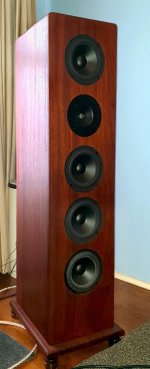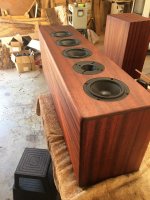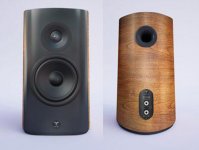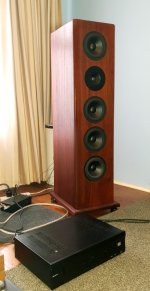Controlling cabinet /front panel vibrations to get the best out of your small signals can be achieved very effectively with this guys stuff Products — Les Davis Audio as used in the Brigadier Mu.2 Serhan Swift | mu2 Mk II Loudspeaker
Indeed Les could template a set of dampers for the tweeter at the very least -going Hi end now �� This stuff works
Indeed Les could template a set of dampers for the tweeter at the very least -going Hi end now �� This stuff works
You just mentioned two very good friends, known Brad Serhan for about 30 years and Morris Swift for a very long time too. We have spent long hours thinking about speaker design theories and what to look for. Brad works very well on the emotional level and that inspires him. Morris is a craggy kind of guy, you better know what you are talking about or you get the short shift. Both are well acquainted with the Elsinore Project and been here many times. They are sure to come and want to listen to the "ULD" version. 'We' are talking about bringing about what the car makers are calling a "concept model" and I can't say too much other than what we are looking at is a 3-Way active speaker system done in a way that is not done before and yes, the technology used in the Elsinores will be in part employed. Maybe take it to a London Hi-Fi Show.
About the constrained layer idea, it is very difficult to get manufacturers to do it right and get the quality right. The other is "differential bass loading" which is done by tuning two cavities just right the right frequencies. What is interesting is that the Elsinores does something similar, instead, it does it on the electrical side. Both are valid ways of doing it, IOHO. That is what that large 18mH and attendant LCR is doing.
About the constrained layer idea, it is very difficult to get manufacturers to do it right and get the quality right. The other is "differential bass loading" which is done by tuning two cavities just right the right frequencies. What is interesting is that the Elsinores does something similar, instead, it does it on the electrical side. Both are valid ways of doing it, IOHO. That is what that large 18mH and attendant LCR is doing.
Last edited:
Is diffraction control on your mind for a speaker with these expensive drivers?
Not sure exactly what you mean? If we are talking about the classic baffle step response/diffraction loss, then the answer is yes. The bottom two drivers play a critical role here. They partly fill in and also help boost sensitivity and efficiency.
No, I'm talking about the edge diffraction of the baffle. E.G. a round-over on the baffle or a chamfer. The waveguided tweeter probably isn't affected, but it might help the woofers meet the tweeters under off-axis angles.
It's just that the budget for the woofers might warrant stepping it up a notch and mind all the little details?
It's just that the budget for the woofers might warrant stepping it up a notch and mind all the little details?
No, I'm talking about the edge diffraction of the baffle. E.G. a round-over on the baffle or a chamfer. The waveguided tweeter probably isn't affected, but it might help the woofers...
Quite so, I have recommended that rounding the edge of the baffle is not a bad idea for those able to do that.
That is about as much rounding as you want as you don't want to reduce baffle area/width too much.
And yes, you are right about the waveguide and the effect it has on the tweeter.
Now please keep in mind that from Mk1 the Elsinore Project was done to make it simple as possible for most DIY'ers and hence butt joints and square corners are OK, but it still allows those with greater skill to add those refinements.
Cheers, Joe
Attachments
Is that a 1/2" roundover? Could you make the cabinet width 1/2" thicker and incorporate 3/4" roundovers? Or would that change the way the speaker behaves too much?
Is that a 1/2" roundover? ...make the cabinet width 1/2" thicker and incorporate 3/4" roundovers? Or would that change...
Still keep the overall width the same. Take look at another picture of the same box as shown above. I think the radius here is 5mm and what you would call 10mm roundover? I would go not go much more than what I see in that pic.
Would any estimate it based on this picture. Is that 5mm radius and hence 10mm diameter?
I know somebody who put a curved panel near the bottom of the box, but did not inpinge on the width of the cabinet and interfere with acoustics. I don't have a picture, but it looked very good, added a kind of Wilson look to it.
Attachments
Last edited:
Thanks Joe. Really hard to tell. It could be a 5mm ~1/4" round over. Just enough to soften the edge nicely.
Indeed, but keep in mind that we are talking DIY and that is what Elsinore has always been about, to make it as accessible as possible. That is why I can't really change the shape. It is strange that commercial manufacturing brings about restraints that homemade DIY does not. But to somebody who comes up with a complex DIY speaker as the Elsinores are, there are restraints on me that are different, but still there.
Let's say you make a box which is curved and you have the skills, or you employ somebody that has, then was bracing scheme are you going to use? Also, what damping are you going to employ? I can see the port would still be in the lower rear of the cabinet, so that is OK and so is the front panel area that could be kept the same. But these are questions that flood my mind if the box design is changed. Yes, it could, but how do you deal with a bunch of variables that may have changed?
If the chance to bring this out as a commercial speaker and use curved panels? I would possibly consider it, but I would use an industrial designer friend of mine and we would have to sit down and knot out the issues.
But I do also admit that I don't mind the current box design and indeed I would add rounded (soft) corners. Notice also the 25mm pedestal on the bottom, also rounded. I am adding that too for those who want that - in updated drawings to comeI suspect too that 'square' boxes might fight back? 😉
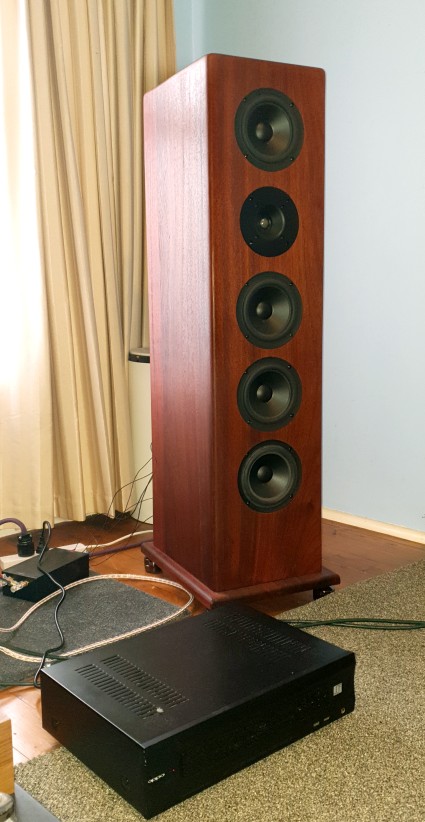
PS: That black box in the picture is a JLTi Upgraded Oppo 105... for those who want to know what pays for the daily bread, that's it, and not the Elsinores - even if that could change, who knows what leads to what?
Let's say you make a box which is curved and you have the skills, or you employ somebody that has, then was bracing scheme are you going to use? Also, what damping are you going to employ? I can see the port would still be in the lower rear of the cabinet, so that is OK and so is the front panel area that could be kept the same. But these are questions that flood my mind if the box design is changed. Yes, it could, but how do you deal with a bunch of variables that may have changed?
If the chance to bring this out as a commercial speaker and use curved panels? I would possibly consider it, but I would use an industrial designer friend of mine and we would have to sit down and knot out the issues.
But I do also admit that I don't mind the current box design and indeed I would add rounded (soft) corners. Notice also the 25mm pedestal on the bottom, also rounded. I am adding that too for those who want that - in updated drawings to comeI suspect too that 'square' boxes might fight back? 😉
PS: That black box in the picture is a JLTi Upgraded Oppo 105... for those who want to know what pays for the daily bread, that's it, and not the Elsinores - even if that could change, who knows what leads to what?
Attachments
Last edited:
just an idea, not sure my cabinet maker will be able to execute this
It is the premium version, yes? 😉
What Joe should be doing (IMO) is getting in touch with CNC wood shops world-wide that can do "on-demand" to provide those baffles in the region/country (*US/UK/France/Germany/etc.) of a potential customer and adding a modest premium to them for himself. He could also add-in the opportunity for a flat pack for the entire loudspeaker.
It's a good way to make more money, not unlike the very nice waveguides he provides - but without the exorbitant shipping and potential taxation (when coming from Australia).
It would also allow for the rare DIY'er to still shop it locally (or DIY it if they have a CNC machine) for themselves and still perhaps make some money by providing the G-code w/ License. Basically a very similar situation with 3D print files provided for payment. Moreover, you could still provide dimensions and a DIY'er could still DIY it with a lot more time involved. Plus of course, the "original" version is still there for DIY'ing.
*ex. here is a potential US source from the DIY community, don't know if Steve would be cost competitive or not - but if considering the idea: it never hurts to ask.
Something a little Different - Trapezoidal Lowther Cabinets
HTGuide Forum
Last edited:
@Scottg that's exactly what I was hoping for, for a premium version 🙂.
Well, great minds think alike of course! 😀
I also think he should be looking into an Viawave SRT-7 (with custom waveguide) option as well.
Last edited:
Yes, it's an interesting tweeter, a few odd things about it though. It is not as inductance-free as the usual ribbon tweeter, and that is a weird sub-1KHz impedance plot. The absence of H5 distortion plot missing in specs and also would like to see what it does when subjected to IMD distortion measurements. But none of these rule out excellent performance. But I am also intrigued by Heil Motion tweeters, they should be nicknamed squeezers the way they work. 😉
Review by Hifi Compass on the non waveguided version might answer some of those questions. Comparing to the waveguided RT850 also measured there you can see that the low end distortion is much better controlled with the sealed ribbons.
Viawave SRT-7 ribbon tweeter | HiFiCompass
Viawave SRT-7 ribbon tweeter | HiFiCompass
- Home
- Loudspeakers
- Multi-Way
- The "Elsinore Project" Thread

